Sunday, 17 June 2007, Compiègne Forest
Written 17 June 2007
The only other party at breakfast this morning consisted of two Brits and an American, and it was interesting to hear them discuss British and American politics. We ran into them at a museum later in the morning, and they were surprised to learn we spoke English—they had assumed we were French, which I guess means we weren't talking too loudly during breakfast and that they weren't worrying about being overheard.
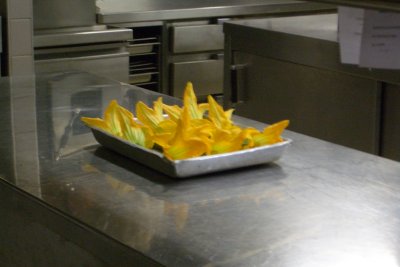 The proprietors told us this morning that we should keep our room keys, because reception and the restaurant are closed after the lunch service on Sundays. Unusually for French hotel rooms, ours open to the exterior (in our case, to an open balcony accessible by an exterior staircase directly from the parking lot behind the hotel), so with keys in hand, we need not pass by reception at all. All the railings and banisters are weathered wood and support a picturesque community of small mosses, lichens, and whatnot. Whimsically, the rooms aren't numbered; CJ's is called "La Goulue," and we're next door in "Les Ducs." On our way out past the open kitchen door, I spotted this pan of fresh squash blossoms, resting in solitary splendor on a counter in the otherwise empty and completely bare kitchen.
The proprietors told us this morning that we should keep our room keys, because reception and the restaurant are closed after the lunch service on Sundays. Unusually for French hotel rooms, ours open to the exterior (in our case, to an open balcony accessible by an exterior staircase directly from the parking lot behind the hotel), so with keys in hand, we need not pass by reception at all. All the railings and banisters are weathered wood and support a picturesque community of small mosses, lichens, and whatnot. Whimsically, the rooms aren't numbered; CJ's is called "La Goulue," and we're next door in "Les Ducs." On our way out past the open kitchen door, I spotted this pan of fresh squash blossoms, resting in solitary splendor on a counter in the otherwise empty and completely bare kitchen.
First order of the day was to visit the "Clairière de l'Armistice," the clearing in the Compiègne Forest where the armistice was signed on 11 November 1918. We were surprised to learn that it wasn't a clearing at the time—it was just a place in the forest, well concealed from the air, where two rail lines (built for military supply) came within a few yards of each other. Field Marshall Foch arrived on one in the converted dining car he used as a field office. The German plenipotentiaries arrived on the other and walked the short distance over to Foch's car, where the talks and signing took place.
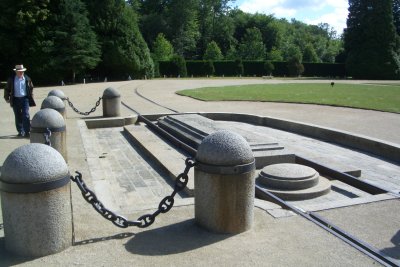 Within a few years after the war, the spot had been cleared and monuments erected. Two short segments of track curve through the area, and the positions of the two rail cars are marked by inscribed monuments set in the ground. A large flat stone tablet in the center in inscribed with a statement to the effect that here on this spot the "criminal arrogance" of the Germans was crushed by the free peoples they had sought to subjugate. Foch's rail car was preserved and displayed there.
Within a few years after the war, the spot had been cleared and monuments erected. Two short segments of track curve through the area, and the positions of the two rail cars are marked by inscribed monuments set in the ground. A large flat stone tablet in the center in inscribed with a statement to the effect that here on this spot the "criminal arrogance" of the Germans was crushed by the free peoples they had sought to subjugate. Foch's rail car was preserved and displayed there.
Needless to say, Hitler was not pleased with these monuments. When the armistice was signed between France and Germany in 1940, he used the same rail car, right there in the clearing, and insisted on sitting in Foch's place at the table. The Germans defaced the large tablet and took it and the rail car back to Germany with them, where the rail car was burned during a later bombing raid (although somebody saved a few pieces and later gave them back to France). The furnishings of the car were in storage somewhere and survived.
After WWII ended, the French located and retrieved the stone tablet, restored it, and replaced it in its spot in the clearing. They found a very similar dining car, rechristened it, and refurnished it for display. It sits inside a small but extremely information-dense museum at the site. You can't go inside the car (or take photos of it), but you can look in through all the windows. Placecards and labels explain what you see.
Besides the rail car, the museum has two rooms devoted to WWI and one to WWII. The cases display dozens of documents and newspaper pages, together with artifacts and related art. In one of the rooms, a couple of dozen old wooden stereo viewers, each presenting 25-30 stereo photographs taken during WWI, give a truly startling view of life in the trenches, the state of various buildings and cities after bombardments, aviation of the period, hospitals, etc. We spent hours but didn't look at them all. Highly, highly recommended.
Written 18 June 2007
Like most things in France, the museum closes for lunch (usually 12:00 to 2:00), so when they threw us out at noon, we set off for Pierrefonds, a sizeable town on the opposite side of the forest from Compiègne. All along the roads were the usual deer-crossing signs, with just the little leaping-deer graphic, but they were interspersed with larger signs saying, essentially, "Seriously, we mean it, watch out; these roads are frequently crossed by large animals," but we never saw any. The forest is crisscrossed by hiking, bicycle, and ATV paths, so bicyclists were everywhere, from serious racers in brightly colored stretch pants to whole families travelling in convoy. We passed ponds set aside for fishing (dug a few hundred years ago by monks, who wanted to raise fish) and a place called "Grimp-à-l'Arb," which I think must be one of those parks where they've strung cables and suspension bridges so that you can walk around among the tree-tops. The forest has some of the oldest beeches and oaks in France, some of the latter supposedly dating from the time of François I.
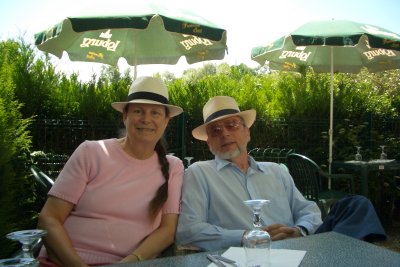 The castle in Pierrefonds is a sizeable tourist draw, so as we had hoped, several places were open and serving lunch. We settled on Crêperie Ouradou, which seated us in the garden, under the pleached linden trees, separated only by a hedge from the water-lily studded local lake, which was busily plied by tourists in pedal boats (a few of them shaped like swans). I had a "Salade Landaise" (greens, lardons, confit gizzards, tomatoes, boiled egg, although, alas, they were out of boiled eggs); David had a "Salade Compagnarde" (greens, tomatoes, fried potatoes, lardons); CJ had a buckwheat crèpe stuffed with tuna, tomatoes, and herbes de Provence. For dessert, CJ got a crèpe filled with dark chocolate and topped with a split and grilled banana, and David and I shared one filled with chestnut cream and extravagantly topped with whipped cream. The physical arrangement was such that the waitresses serving us and our fellow tourists in the garden had to carry all our food and drinks and all the empties and dirty dishes back and forth across the main road through town!
The castle in Pierrefonds is a sizeable tourist draw, so as we had hoped, several places were open and serving lunch. We settled on Crêperie Ouradou, which seated us in the garden, under the pleached linden trees, separated only by a hedge from the water-lily studded local lake, which was busily plied by tourists in pedal boats (a few of them shaped like swans). I had a "Salade Landaise" (greens, lardons, confit gizzards, tomatoes, boiled egg, although, alas, they were out of boiled eggs); David had a "Salade Compagnarde" (greens, tomatoes, fried potatoes, lardons); CJ had a buckwheat crèpe stuffed with tuna, tomatoes, and herbes de Provence. For dessert, CJ got a crèpe filled with dark chocolate and topped with a split and grilled banana, and David and I shared one filled with chestnut cream and extravagantly topped with whipped cream. The physical arrangement was such that the waitresses serving us and our fellow tourists in the garden had to carry all our food and drinks and all the empties and dirty dishes back and forth across the main road through town!
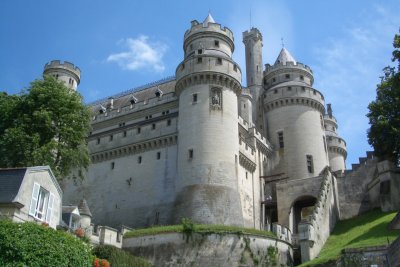
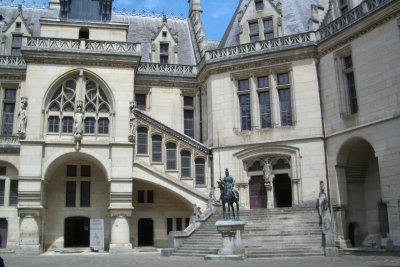 At all of the WWI sites we've visited, including the Armistice Clearing, more than half of the tourists have been British or American, but in Pierrefonds, we were alone among the French tourists. The château was originally built in the 15th century, but it was captured and dismantled later. Napoleon III had it rebuilt and redecorated by Viollet-le-Duc, the Walt Disney of his time, in the 19th century. When Viollet-le-Duc died, his son-in-law Ouradou took over. These photos show parts of the medieval exterior and the rather Renaissance interior courtyard. Of course, Napoleon III didn't last long, so the job was never finished; the building seems to be complete but the decoration (and the guided tour) encompassed only a few of the hundred-odd rooms. We heard no English in Pierrefonds and only a little German (during lunch). The castle provide English-language leaflets, but the tours were in French only.
At all of the WWI sites we've visited, including the Armistice Clearing, more than half of the tourists have been British or American, but in Pierrefonds, we were alone among the French tourists. The château was originally built in the 15th century, but it was captured and dismantled later. Napoleon III had it rebuilt and redecorated by Viollet-le-Duc, the Walt Disney of his time, in the 19th century. When Viollet-le-Duc died, his son-in-law Ouradou took over. These photos show parts of the medieval exterior and the rather Renaissance interior courtyard. Of course, Napoleon III didn't last long, so the job was never finished; the building seems to be complete but the decoration (and the guided tour) encompassed only a few of the hundred-odd rooms. We heard no English in Pierrefonds and only a little German (during lunch). The castle provide English-language leaflets, but the tours were in French only.
Back at the hotel, we dressed up, checked our maps, planned our route, and set off for Restaurant Rive Gauche, in downtown Compiègne. For once, the route worked perfectly—we pulled up to the restaurant right on time, found a parking space right in front (fortunately, as it was beginning to rain), and presented ourselves at the door, only to be faced with a neatly lettered sign saying "Exceptionellement, le restaurant sera fermé dimanche, le 17 juin 2007" ("Exceptionally, the restaurant will be closed Sunday, 7 June 2007."). So there we were, standing in front of a closed restaurant (where we had reservations!) on a deserted street at 8 p.m. on a Sunday, in the rain. A message is no doubt waiting in my e-mail in-box, which I haven't been able to access for a week.
The restaurant in our hotel is always closed on Sunday. So it was back into the car and circle through the downtown a couple of times, looking for a restaurant with its lights on. Several turned out to be open for bar service only—not food—but we finally found Le Brasserie Parisienne.
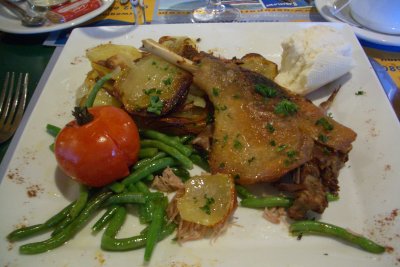 I started with skate salad—boneless bite-size shreds of skate's wing scattered over a large plate of lettuce and tomato with a slightly sweet vinaigrette (well, almost boneless, I found one little square scale armed with a truly impressive hooked spine). David had the house terrine with salad on the side. CJ held out for the main course, a grilled "entrecôte" steak with ratatouille and garlic potatoes on the side. David ordered the leg of duck confit (with green beans, a large roasted tomato, and garlic potatoes), and I had veal kidneys, sautéed rare and topped with a sharp sauce of coarse mustard (with the same green beans and tomato but with boiled potatoes and mushrooms).
I started with skate salad—boneless bite-size shreds of skate's wing scattered over a large plate of lettuce and tomato with a slightly sweet vinaigrette (well, almost boneless, I found one little square scale armed with a truly impressive hooked spine). David had the house terrine with salad on the side. CJ held out for the main course, a grilled "entrecôte" steak with ratatouille and garlic potatoes on the side. David ordered the leg of duck confit (with green beans, a large roasted tomato, and garlic potatoes), and I had veal kidneys, sautéed rare and topped with a sharp sauce of coarse mustard (with the same green beans and tomato but with boiled potatoes and mushrooms).
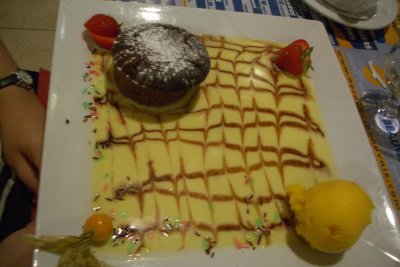 For dessert, David and CJ had the chocolate mi-cuit with orange sorbet, and I had nougat glacé in a lemon sauce. They were all garnished with strawberries and a Jerusalem cherry (Physalis sp.), but I was the only one to eat my Jerusalem cherry; they had no sense of adventure.
For dessert, David and CJ had the chocolate mi-cuit with orange sorbet, and I had nougat glacé in a lemon sauce. They were all garnished with strawberries and a Jerusalem cherry (Physalis sp.), but I was the only one to eat my Jerusalem cherry; they had no sense of adventure.
previous entry
List of Entries
next entry
 The proprietors told us this morning that we should keep our room keys, because reception and the restaurant are closed after the lunch service on Sundays. Unusually for French hotel rooms, ours open to the exterior (in our case, to an open balcony accessible by an exterior staircase directly from the parking lot behind the hotel), so with keys in hand, we need not pass by reception at all. All the railings and banisters are weathered wood and support a picturesque community of small mosses, lichens, and whatnot. Whimsically, the rooms aren't numbered; CJ's is called "La Goulue," and we're next door in "Les Ducs." On our way out past the open kitchen door, I spotted this pan of fresh squash blossoms, resting in solitary splendor on a counter in the otherwise empty and completely bare kitchen.
The proprietors told us this morning that we should keep our room keys, because reception and the restaurant are closed after the lunch service on Sundays. Unusually for French hotel rooms, ours open to the exterior (in our case, to an open balcony accessible by an exterior staircase directly from the parking lot behind the hotel), so with keys in hand, we need not pass by reception at all. All the railings and banisters are weathered wood and support a picturesque community of small mosses, lichens, and whatnot. Whimsically, the rooms aren't numbered; CJ's is called "La Goulue," and we're next door in "Les Ducs." On our way out past the open kitchen door, I spotted this pan of fresh squash blossoms, resting in solitary splendor on a counter in the otherwise empty and completely bare kitchen. Within a few years after the war, the spot had been cleared and monuments erected. Two short segments of track curve through the area, and the positions of the two rail cars are marked by inscribed monuments set in the ground. A large flat stone tablet in the center in inscribed with a statement to the effect that here on this spot the "criminal arrogance" of the Germans was crushed by the free peoples they had sought to subjugate. Foch's rail car was preserved and displayed there.
Within a few years after the war, the spot had been cleared and monuments erected. Two short segments of track curve through the area, and the positions of the two rail cars are marked by inscribed monuments set in the ground. A large flat stone tablet in the center in inscribed with a statement to the effect that here on this spot the "criminal arrogance" of the Germans was crushed by the free peoples they had sought to subjugate. Foch's rail car was preserved and displayed there. The castle in Pierrefonds is a sizeable tourist draw, so as we had hoped, several places were open and serving lunch. We settled on Crêperie Ouradou, which seated us in the garden, under the pleached linden trees, separated only by a hedge from the water-lily studded local lake, which was busily plied by tourists in pedal boats (a few of them shaped like swans). I had a "Salade Landaise" (greens, lardons, confit gizzards, tomatoes, boiled egg, although, alas, they were out of boiled eggs); David had a "Salade Compagnarde" (greens, tomatoes, fried potatoes, lardons); CJ had a buckwheat crèpe stuffed with tuna, tomatoes, and herbes de Provence. For dessert, CJ got a crèpe filled with dark chocolate and topped with a split and grilled banana, and David and I shared one filled with chestnut cream and extravagantly topped with whipped cream. The physical arrangement was such that the waitresses serving us and our fellow tourists in the garden had to carry all our food and drinks and all the empties and dirty dishes back and forth across the main road through town!
The castle in Pierrefonds is a sizeable tourist draw, so as we had hoped, several places were open and serving lunch. We settled on Crêperie Ouradou, which seated us in the garden, under the pleached linden trees, separated only by a hedge from the water-lily studded local lake, which was busily plied by tourists in pedal boats (a few of them shaped like swans). I had a "Salade Landaise" (greens, lardons, confit gizzards, tomatoes, boiled egg, although, alas, they were out of boiled eggs); David had a "Salade Compagnarde" (greens, tomatoes, fried potatoes, lardons); CJ had a buckwheat crèpe stuffed with tuna, tomatoes, and herbes de Provence. For dessert, CJ got a crèpe filled with dark chocolate and topped with a split and grilled banana, and David and I shared one filled with chestnut cream and extravagantly topped with whipped cream. The physical arrangement was such that the waitresses serving us and our fellow tourists in the garden had to carry all our food and drinks and all the empties and dirty dishes back and forth across the main road through town!
 At all of the WWI sites we've visited, including the Armistice Clearing, more than half of the tourists have been British or American, but in Pierrefonds, we were alone among the French tourists. The château was originally built in the 15th century, but it was captured and dismantled later. Napoleon III had it rebuilt and redecorated by Viollet-le-Duc, the Walt Disney of his time, in the 19th century. When Viollet-le-Duc died, his son-in-law Ouradou took over. These photos show parts of the medieval exterior and the rather Renaissance interior courtyard. Of course, Napoleon III didn't last long, so the job was never finished; the building seems to be complete but the decoration (and the guided tour) encompassed only a few of the hundred-odd rooms. We heard no English in Pierrefonds and only a little German (during lunch). The castle provide English-language leaflets, but the tours were in French only.
At all of the WWI sites we've visited, including the Armistice Clearing, more than half of the tourists have been British or American, but in Pierrefonds, we were alone among the French tourists. The château was originally built in the 15th century, but it was captured and dismantled later. Napoleon III had it rebuilt and redecorated by Viollet-le-Duc, the Walt Disney of his time, in the 19th century. When Viollet-le-Duc died, his son-in-law Ouradou took over. These photos show parts of the medieval exterior and the rather Renaissance interior courtyard. Of course, Napoleon III didn't last long, so the job was never finished; the building seems to be complete but the decoration (and the guided tour) encompassed only a few of the hundred-odd rooms. We heard no English in Pierrefonds and only a little German (during lunch). The castle provide English-language leaflets, but the tours were in French only. I started with skate salad—boneless bite-size shreds of skate's wing scattered over a large plate of lettuce and tomato with a slightly sweet vinaigrette (well, almost boneless, I found one little square scale armed with a truly impressive hooked spine). David had the house terrine with salad on the side. CJ held out for the main course, a grilled "entrecôte" steak with ratatouille and garlic potatoes on the side. David ordered the leg of duck confit (with green beans, a large roasted tomato, and garlic potatoes), and I had veal kidneys, sautéed rare and topped with a sharp sauce of coarse mustard (with the same green beans and tomato but with boiled potatoes and mushrooms).
I started with skate salad—boneless bite-size shreds of skate's wing scattered over a large plate of lettuce and tomato with a slightly sweet vinaigrette (well, almost boneless, I found one little square scale armed with a truly impressive hooked spine). David had the house terrine with salad on the side. CJ held out for the main course, a grilled "entrecôte" steak with ratatouille and garlic potatoes on the side. David ordered the leg of duck confit (with green beans, a large roasted tomato, and garlic potatoes), and I had veal kidneys, sautéed rare and topped with a sharp sauce of coarse mustard (with the same green beans and tomato but with boiled potatoes and mushrooms). For dessert, David and CJ had the chocolate mi-cuit with orange sorbet, and I had nougat glacé in a lemon sauce. They were all garnished with strawberries and a Jerusalem cherry (Physalis sp.), but I was the only one to eat my Jerusalem cherry; they had no sense of adventure.
For dessert, David and CJ had the chocolate mi-cuit with orange sorbet, and I had nougat glacé in a lemon sauce. They were all garnished with strawberries and a Jerusalem cherry (Physalis sp.), but I was the only one to eat my Jerusalem cherry; they had no sense of adventure.